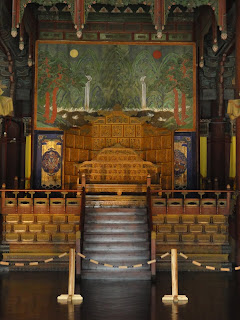The front gate. Built to impress. No one is breaking down those walls!
More serious guards! This guy certainly wasn't going to break character.
The gate inside of main gate. Hehe. Through this gate is the main throne room.
I know by the character on the left that this is a gate. But, I can't remember if this is the main gate to the entire campus, or just the gate before the Throne Room. Mike and Tina! Help! Same bright, intricate paint job as at the other two palaces. Same wood screens and geometric patterns.
In front of the main throne room was another large courtyard where ceremonies were held. On the courtyard were these stone tablets that looked like headstones. In actuality, they are place markers, designating where the different ranks of the government should stand. There were stones 1, 2a, 2b, 3a, 3b, 4, 5, etc. The higher up in the government you were, the lower your tablet number. The one in the foreground is stone marker 10.
The throne room! The ceilings were amazingly high. And another enormous chair.
Beyond the throne room and the living quarters was a lovely garden. There was another square lake with a circular island, but this one had a beautiful building. Very picturesque.
A brick wall inside the palace. Cool designs.
This is a building on the campus that isn't painted. The architecture is the same, but without the paint it looks very different huh?
This building was a large second story pavilion used for hosting guests and parties.
Myself and Mike.
The entire courtyard in front of the throne room is walled in like this.
This is outside of the main palace gates looking at one of the major avenues in Seoul. The palace gates are in front of us.
After the palace, we meet up with Tina and explored the quant neighborhood of Bukchon. The houses all had historic architecture, with stone walls, tiles roofs, and wooden accents. It's a lovely place just to walk around. I do feel bad for the people who actually live in these houses though, as their whole neighborhood is overrun with tourists every weekend. At least they have high walls for privacy.
Glamour shots! Looking good, hunny!
Is this a squirrel? A bear? I don't know, but he's cute.
Myself and Tina.
To end the day, Drew and I went to a theatre show, a musical using traditional instruments and costumes. It was really great. Even Drew enjoyed it, which is saying something. The entire storyline was sung through at the very beginning with English subtitles, so we knew exactly what was going to happen and could understand everything that was going on. During the rest of the show, there wasn't any singing, only music and dancing. But, the story line was so iconic that I bet even without the initial subtitles, we could have followed the story no problem. The dancing was incredible. I've never seen such simple moves be so elegant and expressive. Facial expressions and hand gestures told you everything you needed to know.
During intermission, a small group of actors were on stage doing entertaining acrobatics and tricks, like spinning a plate on a stick. Well, they decided they needed some volunteers from the audience, and they hand picked myself and another plump white guy with almost a mullet. I think our two families were the only Westerners in the audience, hence why they picked us. So, I was pulled onstage to help them perform some of their tricks. I was smiling like an idiot and blushing the whole time. I managed not to mess up anything, so I guess it was a success. For a moment, I was sure Drew had organized the whole thing to embarrass me, but no. :) After the show, in the ladies room, a little old Korean lady came up to me and said, "You, stage, very good job." Maybe I have a future in show biz after all....
The actors from the show are standing, with some audience members in front for a photo. The leads were the lady in red and the man in dark blue.




















































